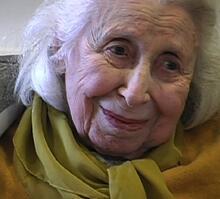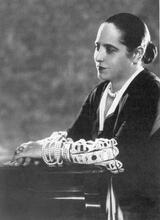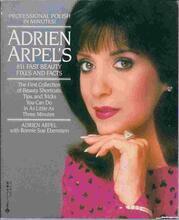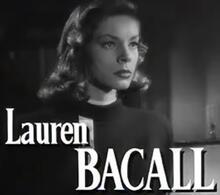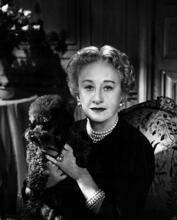Madame d'Ora
Madame d’Ora’s vibrant portraits of twentieth-century artists and intellectuals remain important testaments to European cultural life at the turn of the century and beyond. In 1905 d’Ora became the first woman accepted by the Association of Austrian photographers, and the first woman allowed to study theory at the Graphischen Lehr- und Versuchsanstalt. In 1907 she established her own studio which became a fashionable meeting place for cultural and intellectual elites, and her high-quality photographs of figures such as Josephine Baker and Gustav Klimt received international acclaim. D’Ora was one of the first photographers to focus on the emerging areas of modern, expressive dance and fashion. Her achievements paved the way for other European Jewish women’s careers in photography.
Madame d’Ora’s vibrant portraits of twentieth-century artists and intellectuals remain important testaments to European cultural life at the turn of the century and beyond. Not only did her high quality photographs of well-known figures such as Josephine Baker (1906–1975), Karl Kraus (1874–1936), Arthur Schnitzler (1862–1931) and Gustav Klimt (1862–1918) receive international acclaim, but her studios in Vienna and Paris also became fashionable meeting places for the cultural and intellectual elite. D’Ora’s achievements also paved the way for other European women’s careers in photography, an area in which many Jewish women in particular found success.
Early Life and Family
Dora Philippine Kallmus was born on March 20, 1881 to a Jewish family in Vienna. Her sister Anna was born in 1878 and was deported in 1941. Though her mother, Malvine (née Sonnenberg), died when she was young, her family remained an important source of emotional and financial support in her career. She became interested in the field while assisting the son of the painter Hans Makart, (1840–1884) and in 1905 became the first woman accepted by the Association of Austrian photographers. At that time she was also the first woman allowed to study theory at the Graphischen Lehr- und Versuchsanstalt, which only in 1908 granted women access to other courses in photography.
Early Career
From January to May 1907 she completed an apprenticeship with portrait photographer Nicola Perscheid (1864–1930) in Berlin. There she met Arthur Benda (1885–1969), who later became her professional assistant. After returning to Vienna she established her own studio with the help of her family. Its name—Atelier d’Ora—reflected her love of French culture. Since d’Ora, as a woman, was unable to receive technical training in photography, the move to open her own studio was unusual and risky. However, Benda completed all technical work, while d’Ora obtained clients, set the lighting and poses, and worked on sales and public relations. Her studio achieved rapid popularity among the Viennese elite and in 1916 d’Ora was asked to photograph the coronation of Kaiser Karl (1887–1922), King of Hungary, after which members of the Imperial family visited her studio.
D’Ora’s early clients also included composer Arthur Grünfeld (1852–1924), opera singer Maria Jeritza (1887–1982) and actors Bernhard Baumeister (1828–1917), Fritzi Massary (1882–1969), Ida Roland (1881–1951) and Alexander Girardi (1850–1918). Her Jewish background also helped her gain clients; through her cousin, actress Rosa Bertens (1860–1934), she gained access to clients in the theater, while her relations with composer Erich Korngold (1897–1957) brought her into contact with the world of music. The prominent position of her father, Dr. Philipp Kalmus (?–1914), as a government lawyer brought people from high levels of the civil service, banking and business to her studio. In 1919, d’Ora converted to Roman Catholicism. She never married.
Career Successes
D’Ora was one of the first photographers to focus on the emerging areas of modern, expressive dance and fashion, particularly after 1920, when fashion photographs started to replace drawings in magazines. While her photographic technique was not radical, her avant-garde subject matter was a risky choice for a commercial studio. However, d’Ora’s photographs, which captured her clients’ individuality with new, natural positions in contrast to stiff, old-fashioned poses, quickly became popular.
From 1921 to1926 d’Ora and Benda spent the summers in Karlsbad seeking international clientele and in 1925 opened a studio in Paris together. However, Benda soon returned to Vienna, causing difficulties for d’Ora; in 1927 he took over her studio there, operating it under the name “d’Ora-Benda-Wien.” After this break, d’Ora and Benda never again spoke to each other.
In Paris d’Ora gained access to the international fashion industry and also received long-term contracts from the fashion magazines Die Dame and Officiel de la Couture et de la Mode. Her Paris photographs reflect the glamorous style of her clients there, including designer Coco Chanel (1883–1971), art deco painter Tamara de Lempicka (1898–1980), writer Colette (1873–1954) and performer Maurice Chevalier (1888–1972). In addition, d’Ora often published her own short essays to accompany her photos.
World War II and Postwar Work
D’Ora sold her Paris studio soon after the invasion of the Germans in 1940. Despite her conversion, she remained in danger because of her Jewish background. During the war she hid in a cloister in La Lanvese, in the southern province of Ardèche, and later on a farm. Many of her family were killed in the Holocaust, including her sister Anna.
Both the subject and style of d’Ora’s photographs changed radically after the war. Already in 1945 she documented the plight of refugees at a camp in Austria and in 1956, at the age of seventy-five, completed a series vividly depicting the brutality of Paris slaughterhouses. After she was hit by a motorcycle in 1959, d’Ora lost much of her memory and was unable to work. She spent her remaining years in Frohnleiten, Austria, in the family house that had been forcibly sold under the Nazis but later returned to her. She died on October 28, 1963.
Selected Writings by Madame d’Ora
“Hundeporträts.” Die Dame 4, Berlin (1926): 36.
“Die Jadefigur. Eine Caprice von Mme. D’Ora.” Das Magazin 39, Berlin (1927): 1630.
“Das Auto und die Tänzerin.” Die Dame 19, Berlin (1929): 19.
“Komagiku heißt die kleine Tänzerin.” Das Magazin 69, Berlin (1930): 438.
“Kinderphotos.” Madame, Munich (November, 1955): 26.
Magazine Clients
Die Bühne, Vienna (as of 1923).
Die Dame, Berlin (as of 1920).
Die Damenwelt, Vienna (as of 1917).
Erdgeist, Vienna (1909).
Femina, Paris (as of 1925).
Madame, München (as of 1953).
Das Magazin, Berlin (as of 1926).
Moderne Welt, Vienna (as of 1921).
Officiel de la Couture et de la Mode, Paris (as of 1927).
Vu, Paris (as of 1927).
Das Wiener Magazin, Vienna (as of 1927).
Wiener Salonblatt, Vienna (as of 1910).
Die Woche, Berlin (as of 1914).
Exhibitions
Vienna–Photoklub, 1906.
Vienna–Kunstsalon Heller, 1909.
Budapest, 1910.
Vienna–Kunstsalon Heller, 1912.
Berlin–Kunstsalon Keller und Reiner, 1913.
Buffalo, N.Y.–Professional Photographers’ Society of New York Annual Convention, 1914.
Vienna “Meisterbund österreichischer Photographen,” Arkadenhof des k.u.k. Österreichischen Museums für Kunst und Industrie, 1914.
Vienna–Galerie Arnot, 1916.
Paris–Galerie Montaigne, 1958.
Hamburg–Staatliche Lichtbildstelle, 1969.
Bremen–Landeslichtbildstelle, 1971.
Hamburg–Museum für Kunst und Gewerbe (Perscheid-Benda-d’Ora), 1980.
Auer, Anna and Kunsthalle Wien, eds. Übersee. Flucht und Emigration österreichischer Fotografen 1920–1940. Vienna: 1997.
Faber, Monika. D’Ora: The Photography of Dora Kallmus. Vassar College Art Gallery, Poughkeepsie, NY: 1987.
Faber, Monika. Madame d’Ora, Wien-Paris. Portraits aus Kunst und Gesellschaft 1907–1957. Vienna: 1983.
Geber, Eva and Sonja Rotter. “Madame d’Ora (1881–1963): Eine Wienerin schreibt Photographiegeschichte.” In Das alles war ich: Politikerinnen, Künstlerinnen, Exzentrikerinnen der Wiener Moderne, edited by Frauke Severit, 101–113. Vienna: 1998.
Herrberg, Heike and Weidi Wagner. Wiener Melange: Frauen Zwischen Salon und Kaffeehaus. Berlin: 2002.
Kempe, Fritz. Nicola Perscheid, Arthur Benda, Madame d’Ora. Museum für Kunst und Gewerbe Hamburg: 1980.



